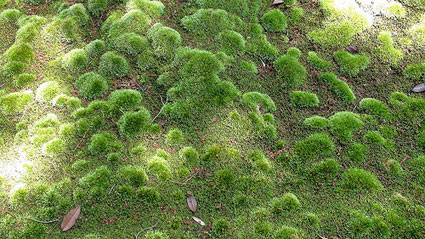Saihoji (Kokedera) Temple 西芳寺
Saihoji Temple - or, as it is more commonly known: Kokedera (苔寺 "moss temple") - was founded in the fourteenth century and is located on a spacious 2 hectares (4.5 acres) in Matsuo, south west Kyoto, 800 meters (half a mile) south west of Matsuno-o Shrine (Matsuo Taisha).
 |
| Moss at Kokedera in western Kyoto, Japan |
Saihoji History
Saihoji was founded in the early to mid eighth century by the Buddhist priest Gyoki (668-749), who is considered the father of mapping and civil engineering in Japan. Subsequent famous head priests of Saihoji include Kukai (AKA Kobo-Daishi) (774-835), another "Renaissance man" of Japanese history known mainly as the founder of the Shingon school of Buddhism, and Honen (1133-1212), the founder of the Pure Land (Jodo-shu) school of Buddhism.
After falling into ruin as a result of civil disturbances and wars, Saihoji was rebuilt, and its gardens redesigned, in 1339 by Muso Soseki (AKA Muso Kokushi) (1275-1351), who was a Zen priest, poet, calligrapher and garden designer.
Saihoji became a World Heritage Site in 1994, along with 16 other Kyoto temples.
 |
| The moss garden is at its best during the Japanese rainy season in June and July but is beautiful at any time of year |
Saihoji Gardens
The garden is split level, with the upper level featuring a kare-sansui traditional dry landscape garden, and the lower level a pond shaped like the kanji for "heart" with a strolling path around it, and designed to give the impression that the pond has a geographical connection with the hills in the background.
This innovative design influenced later generations of garden designers and most famously the garden and temple building were used as models for the building of Ginkakuji Temple.
Ironically, the moss, which is now the temple's biggest draw, is the result of the temple and its gardens having been left to go into disrepair at least a century ago. There are an estimated 120 species of moss at Saihoji covering much of the grounds. Fall is a special time to visit, when the temple's trees color the grounds, but the moss is at its greenest in early summer - May and June.
The famous Kyoto-born artist and epicure, Kitaoji Rosanjin (1883-1959) is buried at Saihoji.
 |
| The temple is one of the most popular with foreign visitors in Kyoto |
Visiting Saihoji - Making A Reservation
A reservation is required to visit Saihoji. Write the temple (see address below) with your name, address in Japan (that of a hotel will do), occupation, age (you must be at least 18), number of people in your group, and the date you wish to visit, plus an alternate date.
Include a self-addressed stamped postcard (ofuku hagaki; 往復はがき) available from the post office or a convenience store, or, if sending from overseas, a postcard with an international reply coupon. The ofuku hagaki is a set of two postcards one of which will be used by Saihoji to reply.
This must be done as early as possible: 2 months or several weeks at least, not days, ahead. Do not show up late for your appointed time.
Note: If you would rather consign the application process, please contact the GoodsFromJapan Concierge Service, which can take of the arrangements for you for a reasonable fee and have the reply from Saihoji posted to your hotel in Japan.
Please contact us to use our service to make an application to visit Saihoji Temple.
*Update: Saihoji now take reservations directly on their website here in English - https://intosaihoji.com/en/booking/nichinichi
The visit fee charged by Saihoji is 4,000 yen per person (up from 3,000 yen), which is the highest in Kyoto. Prior to entering, you will be asked to take part in a period of zazen, the chanting of sutras or calligraphy. This lasts 40 minutes to an hour but allowance is made for people to retire early from this, especially the elderly, infirm or non-Japanese visitors.
 |
| A carpet of moss at Kokedera (Saihoji Temple) in western Kyoto |
Moss Temple Access - how to get to Saihoji
Kyoto Bus #63 from Shijo Kawaramachi and Sanjo Keihan Station is the most straightforward. Get off at Koke-dera/Suzumushi-dera - the final stop. There is only one bus an hour at 27 minutes past the hour. See here for the full timetable: www.kyotobus.jp/route/timetable/pdf/shijokawaramachi_03.pdf
Kyoto Bus #29 starts at Shijo-Karasuma. Get off at Koke-dera-michi bus stop. Go back a little in the direction the bus came from, as far as the footbridge across the main Mozume-kaido Road, and go left there. You will get to Koke-dera in just under 10 minutes.
Kyoto Buses #73 and #28 start at Kyoto Station.
Take bus #73 to the "Kokedera Suzumushidera" stop and walk 3 minutes. There are #73 buses on the hour or just past the hour from 8am to 9pm and at approximately 20 minutes past and 20 minute to the hour. See here for the full timetable. www.kyotobus.jp/route/timetable/pdf/kyotoekimae_02.pdf
On the #28 bus get off at Matsuo-Taisha-mae bus stop. Walk back down the main Mozume-kaido Road in the direction the bus came from, about 12 minutes to the second footbridge, then right down Koke-dera-michi for about 8 minutes.
The nearest train station to Saihoji Temple is JR Saga Arashiyama. From Kyoto Station the journey takes about 12-16 minutes on the JR Sagano Line to Kameoka and Sonobe and costs 240 yen. From JR Saga Arashiyama Station a taxi would cost about 1,000 yen and takes about 10 minutes.
Alternatively from Shijo Station on the Kyoto subway take a Hankyu Arashiyama Line train to Matsuo Taisha Station and walk 20 minutes.
There is also a route from Saihoji by bicycle from Arashiyama.
Saiho-ji
Matsuo Jingatani-cho 56
Nishikyo-ku
Kyoto
615-8286
Tel: 075 391 3631
Book Hotel Accommodation in Kyoto Near Saihoji
Oyama Guesthouse - a budget option close to Saihoji
Hotels in Kyoto - Agoda.com
